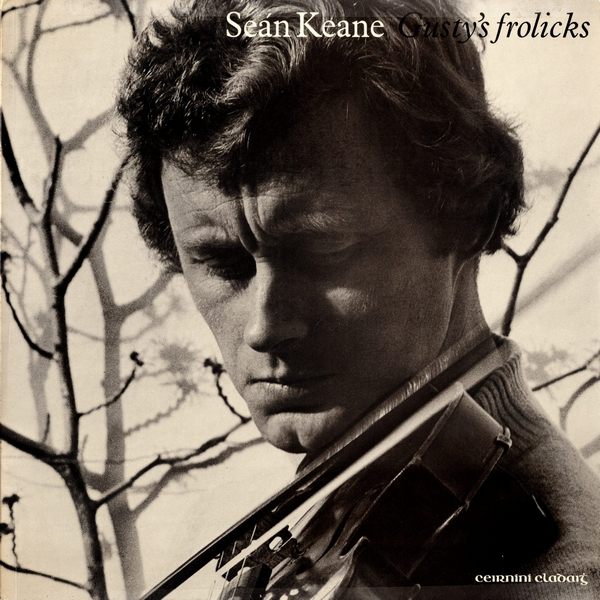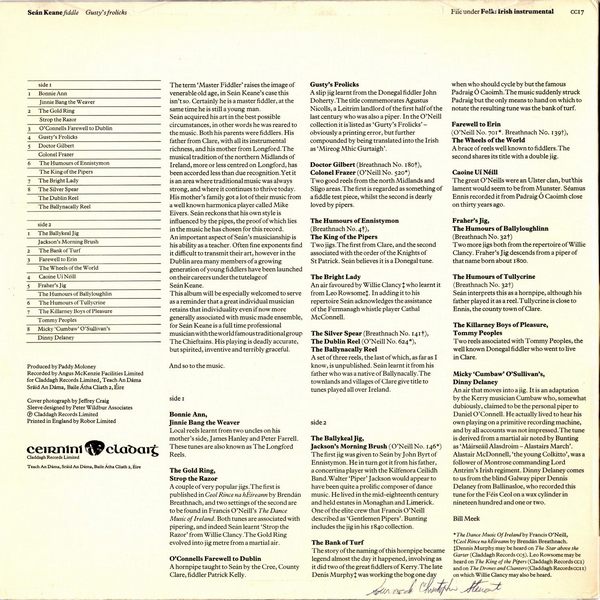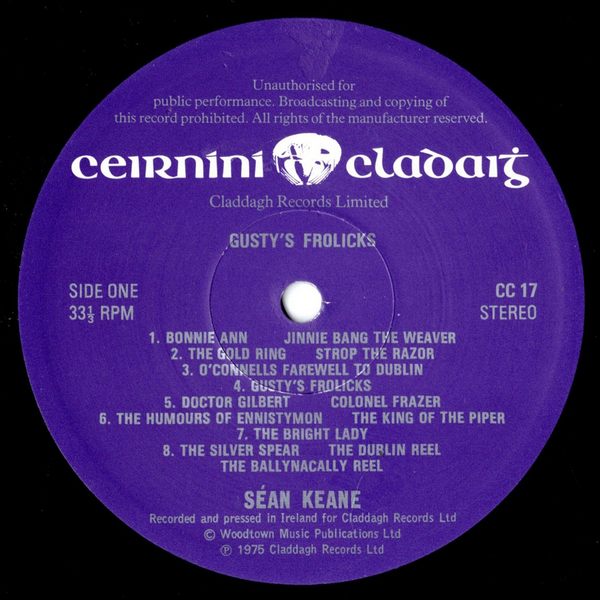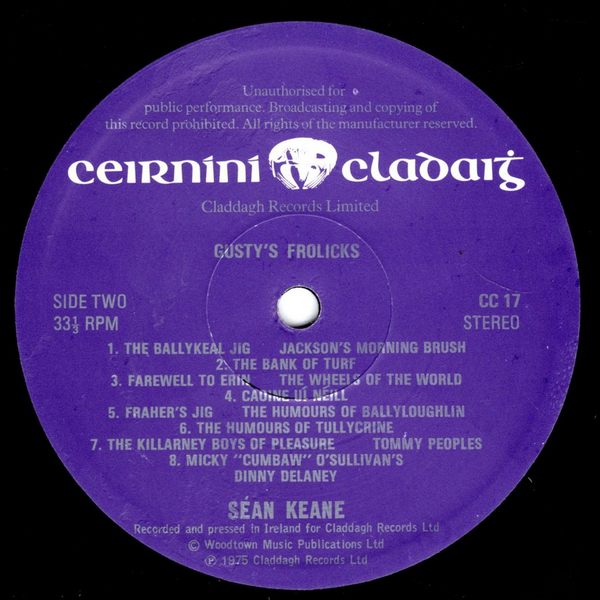
 |



|
Sleeve Notes
The term 'Master Fiddler' raises the image of venerable old age, in Seán Keane's case this isn't so. Certainly he is a master fiddler, at the same time he is still a young man.
Seán acquired his art in the best possible circumstances, in other words he was reared to the music. Both his parents were fiddlers. His father from Clare, with all its instrumental richness, and his mother from Longford. The musical tradition of the northern Midlands of Ireland, more or less centred on Longford, has been accorded less than due recognition. Yet it is an area where traditional music was always strong, and where it continues to thrive today. His mother's family got a lot of their music from a well known harmonica player called Mike Eivers. Seán reckons that his own style is influenced by the pipes, the proof of which lies in the music he has chosen for this record.
An important aspect of Seán's musicianship is his ability as a teacher. Often fine exponents find it difficult to transmit their art, however in the Dublin area many members of a growing generation of young fiddlers have been launched on their careers under the tutelage of Seán Keane.
This album will be especially welcomed to serve as a reminder that a great individual musician retains that individuality even if now more generally associated with music made ensemble, for Seán Keane is a full time professional musician with the world famous traditional group The Chieftains. His playing is deadly accurate, but spirited, inventive and terribly graceful.
And so to the music.
Bonnie Ann & Jinnie Bang the Weaver — Local reels learnt from two uncles on his mother's side, James Hanley and Peter Farrell. These tunes are also known as The Longford Reels.
The Gold Ring & Strop the Razor — A couple of very popular jigs. The first is published in Ceol Rince na hEireann by Brendán Breathnach, and two settings of the second are to be found in Francis O'Neill's The Dance Music of Ireland. Both tunes are associated with pipering, and indeed Seán learnt 'Strop the Razor' from Willie Clancy. The Gold Ring evolved into jig metre from a martial air.
O'Connells Farewell to Dublin — A hornpipe taught to Seán by the Cree, County Clare, fiddler Patrick Kelly.
Gusty's Frolicks — A slip jig learnt from the Donegal fiddler John Doherty. The title commemorates Agustus Nicolls, a Leitrim landlord of the first half of the last century who was also a piper. In the O'Neill collection it is listed as 'Gurty's Frolicks' — obviously a printing error, but further compounded by being translated into the Irish as 'Mireog Mhic Gurtaigh'.
Doctor Gilbert (Breathnach No. 180**) & Colonel Frazer (O'Neill No. 520*) — Two good reels from the north Midlands and Sligo areas. The first is regarded as something of a fiddle test piece, whilst the second is dearly loved by pipers.
The Humours of Ennistymon (Breathnach No. 4**) & The King of the Pipers — Two jigs. The first from Clare, and the second associated with the order of the Knights of St Patrick. Seán believes it is a Donegal tune.
The Bright Lady — An air favoured by Willie Clancy *** who learnt it from Leo Rowsome***. In adding it to his repertoire Seán acknowledges the assistance of the Fermanagh whistle player Cathal McConnell.
The Silver Spear (Breathnach No. 141**), The Dublin Reel (O'Neill No. 624*) & The Ballynacally Reel — A set of three reels, the last of which, as far as I know, is unpublished. Seán learnt it from his father who was a native of Ballynacally. The townlands and villages of Clare give title to tunes played all over Ireland.
The Ballykeal Jig & Jackson's Morning Brush (O'Neill No. 146*) — The first jig was given to Seán by John Byrt of Ennistymon. He in turn got it from his father, a concertina player with the Kilfenora Ceilidh Band. Walter 'Piper' Jackson would appear to have been quite a prolific composer of dance music. He lived in the mid-eighteenth century and held estates in Monaghan and Limerick. One of the elite crew that Francis O'Neill described as 'Gentlemen Pipers'. Bunting includes the jig in his 1840 collection.
The Bank of Turf — The story of the naming of this hornpipe became legend almost the day it happened, involving as it did two of the great fiddlers of Kerry. The late Denis Murphy *** was working the bog one day when who should cycle by but the famous Padraig ó Caoimh. The music suddenly struck Padraig but the only means to hand on which to notate the resulting tune was the bank of turf.
Farewell to Erin (O'Neill No. 701*. Breathnach No. 139**) & The Wheels of the World — A brace of reels well known to fiddlers. The second shares its title with a double jig.
Caoine Uí Néill — The great O'Neills were an Ulster clan, but this lament would seem to be from Munster. Séamus Ennis recorded it from Padraig ó Caoimh close on thirty years ago.
Fraher's Jig & The Humours of Ballyloughlinn (Breathnach No. 32**) — Two more jigs both from the repertoire of Willie Clancy. Fraher's Jig descends from a piper of that name born about 1800.
The Humours of Tullycrine (Breathnach No. 32**) — Seán interprets this as a hornpipe, although his father played it as a reel. Tullycrine is close to Ennis, the county town of Clare.
The Killarney Boys of Pleasure & Tommy Peoples — Two reels associated with Tommy Peoples, the well known Donegal fiddler who went to live in Clare.
Micky 'Cumbaw' O'Sullivan's & Dinny Delaney — An air that moves into a jig. It is an adaptation by the Kerry musician Cumbaw who, somewhat dubiously, claimed to be the personal piper to Daniel O'Connell. He actually lived to hear his own playing on a primitive recording machine, and by all accounts was not impressed. The tune is derived from a martial air noted by Bunting as 'Máirseáil Alasdroim — Alastairs March'. Alastair McDonnell, 'the young Colkitto', was a follower of Montrose commanding Lord Antrim's Irish regiment. Dinny Delaney comes to us from the blind Galway piper Dennis Delaney from Ballinasloe, who recorded this tune for the Féis Ceol on a wax cylinder in nineteen hundred and one or two.
Bill Meek